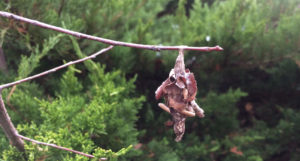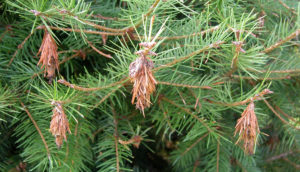This advisory provides; (1) warm season spider mite biology and control options, (2) current growing degree-day information, and (3) a boxwood blight risk update.
Note: Previous spider mite advisories
Steve Rettke, Rutgers IPM, wrote two very good advisory posts pertaining to the different seasonal mites, in addition to symptomology and images of the different mites. He is a wealth of information and has contributed photos and will be assisting in future fact-sheets pertaining to common pests and their control. In light of these advisory posts (below) this current advisory will only cover the basics as it applies to pest control. Contact: rettke@njaes.rutgers.edu
Please review his very informative advisories:
Cool season mites: https://plant-pest-advisory.rutgers.edu/cool-season-mites-wax-as-the-warm-season-mites-wane/
Warm season mites: https://plant-pest-advisory.rutgers.edu/cool-season-mites-have-faded-but-warm-season-mites-now-surge/
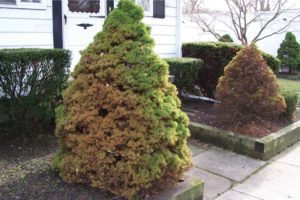
Cool season: Spruce spider mite damage on an Aberta Dwarf Spruce. Photo: Steven Rettke, RCE.
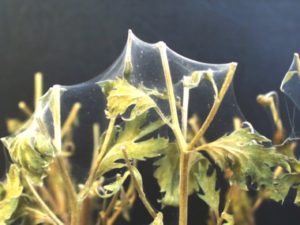
Warm season: Two spotted spider mite webbing and damage. Photo: Steven Rettke, RCE.
(2) Basic spider mite biology and control options
Cool season mites: The mites affecting horticulture crop production can be broken into two functional groups; cool season and warm season. Cool season mites feed and lay eggs, as the name suggests, in cooler times of the year (late winter-early spring and then again fall-early winter depending on the year). The two most common cool season mites are the Spruce and Southern red spider mites that feed on conifers and broadleaf evergreens, respectively. In many cases the damages caused by these mites are not noticed until well into the growing season. Meaning that if damages are observed mid-season you would be better off waiting until the fall to control cool season mites, i.e. targeting late season egg hatches and developing mites.
Warm season mites: As the season progresses towards summer, the warm season mites including Two-spotted, Maple, Oak, Honey locust, European, and other host specific spider mites become active (typically June – September). The Two-spotted spider mite is known as a “cosmopolitan” pest because of its ability to colonize, and damage, a wide variety of horticulture crops (but are rarely observed on conifers). Sentinel plants would include rose, euonymus, and forsythia, as they are favorites of these mites. In contrast to the cool season mites, warm season mite damages are often visible while the pest is actively feeding and multiplying, as up to 10-15 generations per growing season can impact your crop. Warm season mites evade suffocation by dormant oil sprays and other miticide applications by leaving their feeding locations on plants once temperatures begin to drop, and overwinter in the soil horizon or leaf litter under the host plant. As warm season mites are preparing to go into dormancy they begin to change their color to an orange hue, meaning they are not feeding as readily and will not be as affected by miticides because of this.
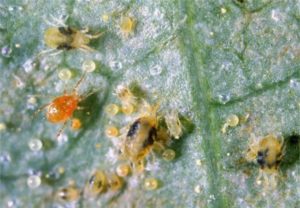
Multiple life stages of Two spotted spider mites. Photo: Steven Rettke, RCE.
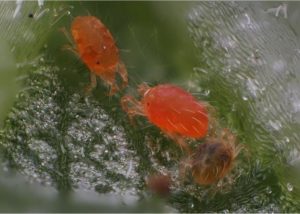
Two spotted spider mite females going into dormancy (orange coloration). Photo: Steven Rettke, RCE.
Conditions favoring spider mites: Full sun and dry, dusty conditions are often associated with increasing mite populations as low relative humidity often stimulates mite reproduction. Additionally, during periods of rain (and resulting leaf wetness-periods), certain fungi are able to attack and reduce mite populations (called entomopathogenic fungi). Meaning in frequently wet seasons mite numbers, damage, and miticide applications should be lowered due to increased fungal activity. However, this situation can certainly lead to increased plant pathogenic fungi activity as well, therefor a balance between the two is most desirable. Excessive nitrogen fertilizer has also been linked to explosive mite populations; therefor a well-planned nutritional regiment should be strictly followed.
IPM is important when suppressing spider mite populations!
Beneficials: In addition to entomopathogenic fungi (like Beauveria bassiana), numerous beneficial organisms can also manage mite populations including predacious mites (Phytoseiidae family), spider mite destroyer (Stethorus punctillim), ladybug larvae, midge larvae (Feltiella acarisuga), and minute pirate bugs. Given this complex, and many times free, natural defense system, applications of certain insecticides can actually cause mite populations to resurge by killing the mite-feeding beneficials (see note below). Therefor, all applications should be thoughtfully considered with economic (or cosmetic) thresholds in mind.
Compounds that can cause spider mite resurgence:
- Carbaryl (Sevin)
- Cyfluthrin containing compounds (Tempo, Decathalon, Scimitar)
- Permethrin (Astro)
- Imdacloprid (Merit, Marathon)
Warm season spider mite treatment options:
ROTATE between Insecticide Resistance Action Committee (IRAC #)
Format: [IRAC Group #]: Chemical name (Trade names)
- [3A]: Pyrethrins (Tersus)
- [5]: Spinosad (Conserve, Entrust)
- [6]: Abamectin (Avid, Lucid, Aracinate TM)
- [20D]: Bifenazate (Floramite SC)
- [10A]: Hexythiazox (Hexygon)
- [21A]: Pyridaben (Sanmite, Sanmite SC)
- [21A]: Fenazaquin (Magus)
- [23]: Spiromesifen (Forbid 4F, Judo)
“Softer” spider mite materials
- Agitator (forces mites out of hiding): Captiva
- Azadirachtin from the Neem plant: (Azatrol EC)
- Beauveria bassiana: (Naturalis-L)
- Horticulture oil: (@ 1-2% vol:vol summer applications)
- Insecticidal soaps: (M-Pede)
Always refer to the label for allowable host crops, use-restrictions, application rates, reapplication intervals, REI times, and mix compatibility information.
NOTE: Production and pesticide information on this site are for commercial operators only and are NOT for home gardener use. Provided materials represent examples and do not cover all possible control scenarios. Please contact your local agent or chemical sales representative for more information.
(2) Growing Degree-days as of 6/16/2020 (if you need help please contact me at twaller@njaes.rutgers.edu)
Upper Deerfield (NJ50)= 809 GDD50 Howell/Freehold (NJ10) = 628 GDD50 Pequest (NJ58) = 525 GDD50
Growing degree day map for our area: (courtesy of Cornell University; Fore Cast)
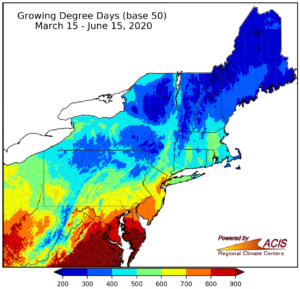
Growing degree-day map for our area. Cornell, Fore Cast.
(3) Boxwood blight risk update
| Boxwood Blight Risk Model | ||||
| Date | Upper Deerfield (NJ50) | Howell (NJ10) | Pequest (NJ58) | |
| 6/14/20 | Sun | Very low risk | Very low risk | Very low risk |
| 6/15/20 | M | Very low risk | Very low risk | Very low risk |
| 6/16/20 | T | Very low risk | Very low risk | Very low risk |
| 6/17/20 | W | Very low risk | Very low risk | Very low risk |
| 6/18/20 | Th | Low risk | Low risk | Low risk |
| 6/19/20 | F | Infection potential | Infection potential | Low risk |
| 6/20/20 | S | Low risk | Infection potential | Low risk |
| 6/21/20 | Sun | Very low risk | Low risk | Very low risk |
| Risk of infection | ||||
| adapted from: https://uspest.org/risk/boxwood_app | ||||
Please visit this website (there is a mobile app as well): https://uspest.org/risk/boxwood_app
Protective fungicide applications should remain in effect or be initiated immediately for Boxwood Blight. The disease may be sporulating and spreading amongst plantings if present (or may come into your nursery via shipments) within the next few days. Please continue preventative/protectant fungicide applications utilizing; chlorothalonil (FRAC Group M05), mancozeb (FRAC Group M03), and QoI-fungicides (FRAC Group 11) in a rotation (other materials available as well).
NJAES; Plant Diagnostic Lab https://njaes.rutgers.edu/plant-diagnostic-lab/
*Additional links and resources*
Please take the 2020 Nursery Industry Survey: https://forms.gle/dUjLxaiu6qDQYYsRA
Ask the Agent (every Wednesday @ 7:00pm): : https://go.rutgers.edu/t7wjkit1
NJNLA- Wine Down Wednesdays (every first and third Wednesday @ 7:00pm-8:00pm).
Email: Lori Jenssen @ njnla.director@gmail.com
Subscribe to the NJAES YouTube webpage: https://www.youtube.com/user/RutgersNJAES/
RU Sustainable Nursery Production website: https://njaes.rutgers.edu/nursery/
March meeting PDF: https://njaes.rutgers.edu/nursery/documents/2020%20SJ%20Nursery%20Meeting%20Proceedings.pdf
How to use growing degree-day resources: https://plant-pest-advisory.rutgers.edu/using-growing-degree-day-calculators-nursery-pest-and-pathogen-updates-important-resource-links/
2017 Southeastern U.S. Pest Control Guide for Nursery Crops and Landscape Plantings: https://content.ces.ncsu.edu/southeastern-us-pest-control-guide-for-nursery-crops-and-landscape-plantings
Rutgers Insect Control Recs. for Shade Trees and Commercial Nursery Crops: https://njaes.rutgers.edu/pubs/publication.php?pid=E334
NJAES; Soil Testing Lab: https://njaes.rutgers.edu/soil-testing-lab/
Thank you,
Cumberland County Extension: Timothy J. Waller, Ph.D. @ twaller@njaes.rutgers.edu
